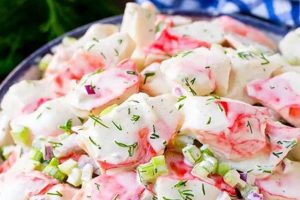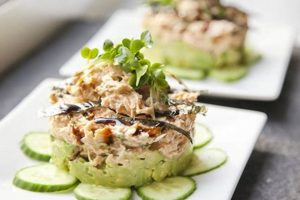Recipes utilizing canned crab meat offer a convenient and accessible approach to preparing this popular dish. Such recipes typically involve combining drained crab meat with mayonnaise, celery, onion, and seasonings. Variations may include additions such as mustard, relish, lemon juice, or Old Bay seasoning. A simple example involves mixing canned crab, mayonnaise, chopped celery, and diced red onion, seasoned with salt and pepper.
The accessibility of canned crab makes these recipes particularly appealing for those seeking a quick and easy meal or appetizer. This convenience factor contributes to the enduring popularity of such dishes, particularly for those without access to fresh crab or those seeking a time-saving option. Historically, the advent of canning technology expanded the availability of seafood, including crab, to inland areas and allowed for year-round consumption. This contributed significantly to the development of recipes using canned seafood as a primary ingredient.
Further exploration of this topic will cover specific recipe variations, nutritional information, tips for selecting high-quality canned crab, and safe handling practices.
Tips for Recipes Utilizing Canned Crab
Optimizing recipes using canned crab involves attention to ingredient selection and preparation techniques. The following tips offer guidance for creating flavorful and enjoyable dishes.
Tip 1: Drain Thoroughly: Excess liquid from the can can dilute the flavor and create a watery salad. Thorough draining is crucial for achieving optimal texture and taste. Pressing the crab meat gently against a sieve or colander aids in removing excess liquid.
Tip 2: Quality Matters: Opt for high-quality canned crab meat, typically labeled as “lump” or “jumbo lump.” These grades offer larger, more intact pieces, resulting in a superior salad. Checking ingredient lists for additives or fillers is also recommended.
Tip 3: Enhance, Don’t Overpower: Seasonings should complement the delicate flavor of crab, not mask it. Classic combinations include Old Bay, dill, lemon juice, and Dijon mustard. Start with small amounts and adjust to taste.
Tip 4: Balance the Binder: Mayonnaise is the typical binder in crab salad. Using too much can result in a heavy, overly rich dish. Start with a modest amount and add more as needed to achieve the desired consistency. Greek yogurt can be incorporated to lighten the texture and reduce overall fat content.
Tip 5: Textural Variety: Incorporating finely diced celery and red onion provides textural contrast and adds depth of flavor. Other additions, such as chopped bell peppers or water chestnuts, can further enhance the salad’s complexity.
Tip 6: Chill Before Serving: Chilling allows the flavors to meld and enhances the overall experience. Refrigerate the prepared salad for at least 30 minutes before serving. This also improves food safety.
Attention to these details elevates canned crab salad from a simple dish to a culinary delight. Proper draining, ingredient selection, and balanced seasoning are key factors in achieving optimal flavor and texture.
By following these tips, one can consistently create delicious and satisfying crab salad using readily available canned crab meat, providing a convenient and enjoyable meal or appetizer.
1. Ingredient Selection
Ingredient selection significantly impacts the quality and flavor profile of crab salad prepared with canned crab meat. The quality of the canned crab itself is paramount. “Lump” or “jumbo lump” designations signify larger, more intact pieces of crab, yielding a superior texture compared to smaller, shredded varieties often labeled “claw” or “special.” Lower-quality canned crab may contain shell fragments or cartilage, detracting from the overall experience. Careful examination of the ingredient list on the can is advisable, prioritizing products with minimal additives or fillers.
Beyond the crab, the selection of complementary ingredients is crucial. Fresh, crisp vegetables such as celery and red onion provide essential textural contrast and enhance the flavor. Limp or aged vegetables can negatively impact both the taste and appearance of the salad. The choice of mayonnaise also plays a critical role; a high-quality mayonnaise complements the crab flavor, while a lower-quality product can introduce unwanted sweetness or tang. Similarly, the judicious use of seasonings such as Old Bay, dill, or lemon juice elevates the flavor profile without overpowering the delicate taste of the crab.
Effective ingredient selection, therefore, represents a foundational element in preparing a successful crab salad using canned crab. Prioritizing high-quality canned crab and fresh produce, coupled with careful consideration of complementary seasonings and binders, ensures a flavorful and enjoyable culinary outcome. Failing to prioritize ingredient quality can result in a bland, watery, or otherwise unappetizing salad. Understanding the importance of each ingredient and its contribution to the final product is essential for achieving a balanced and delicious crab salad.
2. Preparation Techniques
Preparation techniques significantly influence the final quality of crab salad utilizing canned crab meat. Proper execution of these techniques ensures optimal texture, flavor, and food safety. A key initial step involves thoroughly draining the canned crab. Residual liquid contributes to a watery consistency, diluting the flavor and compromising the overall appeal. Gentle pressing of the crab meat against a fine-mesh sieve or colander effectively removes excess liquid without damaging the delicate texture. Failure to adequately drain the crab can result in a soupy salad lacking in flavor and visual appeal.
Beyond draining, careful handling of the crab meat is essential. Overmixing can break down the crab into smaller, less desirable pieces. A light touch is recommended when combining the crab with other ingredients, ensuring the mixture remains cohesive while preserving the integrity of the crab meat. The manner in which other ingredients are prepared also impacts the final result. Uniformly dicing vegetables such as celery and onion ensures even distribution of flavor and texture throughout the salad. Unevenly chopped ingredients can create pockets of intense flavor or distractingly large pieces.
Appropriate chilling techniques further enhance the final product. Refrigerating the prepared salad for a sufficient period allows the flavors to meld and develop complexity. Furthermore, chilling safeguards against bacterial growth, promoting food safety. Serving the salad at a chilled temperature enhances its refreshing qualities, particularly in warmer climates. Neglecting proper chilling can lead to a less flavorful salad and potentially compromise food safety. Mastering these preparation techniques elevates canned crab salad from a simple convenience food to a carefully crafted dish, highlighting the delicate flavor and texture of the crab while ensuring a safe and enjoyable dining experience.
3. Flavor Balancing
Flavor balancing is paramount in recipes utilizing canned crab meat, ensuring the delicate flavor of the crab isn’t overwhelmed while other components contribute positively to the overall profile. A well-balanced crab salad offers a harmonious blend of flavors, where no single element dominates. This balance is achieved through careful consideration of the interplay between the crab, binder, vegetables, and seasonings.
- Acidity
Acidity plays a vital role in brightening the flavor profile and cutting through the richness of the mayonnaise or other binder. Lemon juice or a splash of vinegar introduce a refreshing tartness that balances the sweetness of the crab and the fattiness of the mayonnaise. Without sufficient acidity, the salad can taste bland and heavy. Conversely, excessive acidity can overpower the delicate crab flavor. A judicious amount of acid enhances the overall taste experience.
- Saltiness
Salt enhances the inherent flavors of the crab and other ingredients. However, the salt content in canned crab can vary, necessitating careful seasoning. Adding salt gradually, tasting frequently, prevents over-salting. Other salty elements, such as Old Bay seasoning or a touch of Worcestershire sauce, can contribute to the overall salt balance while adding complementary flavors. Insufficient salt results in a flat, unappealing salad, while excessive salt masks the subtle nuances of the crab.
- Texture
While not strictly a flavor element, texture significantly impacts the perceived taste. The textural contrast between the tender crab meat and crisp vegetables like celery and onion creates a more engaging and satisfying culinary experience. A monotonous texture can make the salad seem less appealing, even if the flavors are well-balanced. The creamy texture of the mayonnaise also plays a role, binding the ingredients together while adding a layer of richness. Achieving textural balance elevates the enjoyment of the salad.
- Aromatics
Aromatics contribute to the overall sensory experience. Fresh herbs like dill or chives provide a bright, herbaceous note that complements the crab. Spices such as Old Bay seasoning offer a complex blend of warmth and subtle heat. These aromatics enhance the flavor profile, adding depth and complexity beyond the basic ingredients. The careful selection and application of aromatics can transform a simple crab salad into a more nuanced and flavorful dish.
Successfully balancing these flavor components results in a crab salad that highlights the natural sweetness and delicate flavor of the crab, creating a harmonious and satisfying dish. Each element plays a crucial role in the overall flavor profile, and attention to detail in balancing these elements is essential for producing a truly exceptional crab salad using canned crab meat.
4. Food Safety
Food safety is paramount when preparing dishes using canned crab meat. Clostridium botulinum, the bacterium responsible for botulism, is a particular concern with improperly handled canned goods. While commercial canning processes generally eliminate this risk, improper storage or handling after opening can create conditions conducive to bacterial growth. Crab meat, being highly perishable, requires careful attention to temperature control throughout the preparation and serving process. Maintaining appropriate refrigeration temperatures, below 40F (4C), inhibits bacterial proliferation and minimizes the risk of foodborne illness. Consuming crab salad that has been left at room temperature for extended periods, particularly in warm environments, significantly increases the risk of bacterial contamination and should be avoided. A real-world example illustrating the consequences of neglecting food safety involves a 2018 incident where numerous individuals experienced botulism after consuming improperly home-canned crab meat.
Beyond botulism, other bacterial contaminants, such as Listeria monocytogenes and Salmonella, can also proliferate in improperly handled crab salad. These bacteria can cause severe gastrointestinal distress and, in vulnerable populations, potentially life-threatening complications. Cross-contamination from other food items or unclean surfaces further exacerbates the risk. Thoroughly washing hands, utensils, and preparation surfaces minimizes this risk. Additionally, using separate cutting boards and utensils for raw ingredients and ready-to-eat foods prevents cross-contamination. Proper handwashing, for at least 20 seconds with soap and warm water, is crucial before and after handling crab meat. These preventative measures significantly reduce the risk of bacterial contamination and contribute to a safer dining experience.
In conclusion, meticulous adherence to food safety guidelines is essential when preparing and consuming crab salad made with canned crab meat. Proper refrigeration, thorough handwashing, and preventing cross-contamination are crucial steps in mitigating the risks associated with foodborne illnesses. Neglecting these precautions can have serious health consequences. Understanding and implementing these food safety practices ensures a safe and enjoyable culinary experience, allowing individuals to confidently incorporate canned crab meat into their meals.
5. Serving Suggestions
Serving suggestions enhance the enjoyment of crab salad prepared with canned crab meat, elevating it from a simple mixture to a more complete and appealing culinary experience. Consideration of complementary flavors, textures, and presentation transforms the dish, offering a range of options suitable for various occasions, from casual lunches to more formal gatherings. Appropriate serving suggestions maximize the potential of canned crab salad, showcasing its versatility and culinary appeal.
- Classic Bread Pairings
Serving crab salad on bread or crackers provides a familiar and satisfying base. Options range from simple white bread or saltine crackers to more robust choices like sourdough, rye, or multigrain bread. Mini croissants or toasted baguette slices offer a more elegant presentation. The bread’s neutral flavor balances the richness of the crab salad, while its texture provides a pleasant contrast to the creamy filling. For example, a crab salad sandwich on toasted rye with crisp lettuce offers a classic lunchtime option.
- Lettuce Wraps and Vegetables
For a lighter and healthier alternative, crab salad can be served in lettuce cups, scooped onto endive leaves, or nestled within hollowed-out tomato halves or avocado boats. These options offer a refreshing crunch and a visually appealing presentation. The vegetal flavors complement the crab, creating a lighter, more summery dish. Serving crab salad with sliced cucumbers, bell peppers, or cherry tomatoes enhances the freshness and nutritional value.
- Elevated Presentations
For more formal occasions, consider serving crab salad as an appetizer in elegant tart shells, on top of blinis, or presented as deviled eggs topped with a dollop of crab salad. Garnishing with fresh herbs like dill or chives, a sprinkle of paprika, or a wedge of lemon elevates the presentation and adds visual interest. These options offer a more refined and sophisticated approach to serving canned crab salad.
- Complementary Sides and Beverages
The choice of accompanying side dishes further enhances the overall dining experience. A simple green salad with a light vinaigrette, a classic potato salad, or a fruit salad provide refreshing contrasts to the richness of the crab salad. Beverage pairings also play a role; a crisp white wine, a light beer, or iced tea complement the flavors of the crab salad without overpowering them. For instance, a chilled Sauvignon Blanc paired with crab salad served on endive leaves offers a light and refreshing summer meal.
Thoughtful consideration of serving suggestions significantly impacts the enjoyment of crab salad made with canned crab. By exploring various options and understanding the interplay of flavors, textures, and presentations, one can elevate this simple dish to a versatile and satisfying culinary creation suitable for a range of occasions and palates. Choosing complementary accompaniments enhances the overall experience, transforming canned crab salad from a convenient staple into a memorable meal.
Frequently Asked Questions
This section addresses common inquiries regarding the preparation and consumption of crab salad made with canned crab meat.
Question 1: What type of canned crab is best suited for crab salad?
While various types of canned crab exist, “lump” or “jumbo lump” crab meat is generally preferred for crab salad due to its larger, more intact pieces, resulting in superior texture and flavor. “Claw” meat, while more budget-friendly, tends to be shredded and smaller.
Question 2: How can one minimize the “canned” taste sometimes associated with canned crab?
Thoroughly draining and rinsing the crab meat under cold water can help reduce any lingering metallic or “canned” taste. Furthermore, incorporating fresh ingredients like lemon juice, herbs, and spices can enhance the overall flavor profile, masking any residual off-notes.
Question 3: What are the key indicators of spoiled canned crab meat?
Spoiled canned crab may exhibit a strong, unpleasant odor, a slimy texture, or discoloration. Swelling or dents in the can itself may also indicate spoilage. If any of these signs are present, the product should be discarded immediately.
Question 4: How long can prepared crab salad be safely stored in the refrigerator?
Prepared crab salad should be stored in an airtight container in the refrigerator at or below 40F (4C). For optimal quality and safety, it’s recommended to consume the salad within three to five days.
Question 5: Can crab salad be frozen?
Freezing crab salad is generally not recommended. Freezing alters the texture of the mayonnaise and other ingredients, resulting in a watery and less desirable consistency upon thawing. For optimal quality, it’s best to prepare and consume crab salad fresh.
Question 6: What are some common allergens associated with crab salad?
Crab itself is a shellfish allergen. Additionally, depending on the recipe, common allergens such as dairy (from mayonnaise), gluten (from bread or crackers used for serving), and soy (from certain seasonings or sauces) may be present. Individuals with allergies should carefully review ingredient lists and exercise caution when consuming crab salad.
Understanding these frequently asked questions facilitates safe and informed preparation and consumption of crab salad made with canned crab. Prioritizing food safety and selecting high-quality ingredients ensures an enjoyable culinary experience.
The next section will explore variations on the classic canned crab salad recipe, offering inspiration for creative culinary endeavors.
Conclusion
Exploration of canned crab salad recipes reveals a readily accessible and versatile culinary option. Careful selection of quality canned crab meat, combined with appropriate preparation techniques and balanced flavor profiles, yields a satisfying dish. Strict adherence to food safety guidelines ensures a safe and enjoyable dining experience. Serving suggestions, ranging from classic pairings to more innovative presentations, further elevate the culinary potential of canned crab salad. Addressing common queries regarding ingredient selection, preparation methods, and storage provides a comprehensive understanding of this adaptable dish.
Canned crab salad recipes offer a convenient entry point for culinary exploration. The potential for creativity within this seemingly simple dish warrants further experimentation and personalized adaptations. Continued appreciation for this accessible and adaptable culinary staple ensures its enduring presence in kitchens worldwide.






